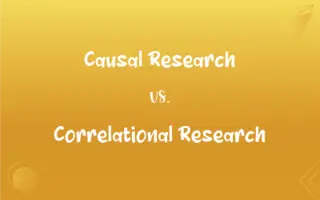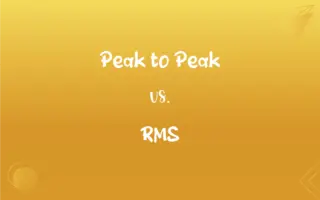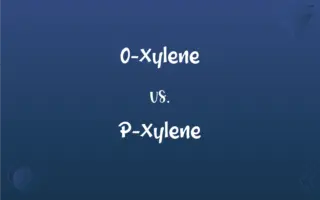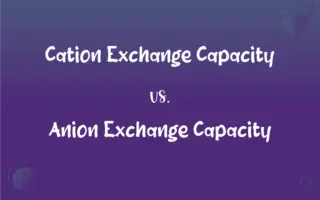RTP vs. RTCP: What's the Difference?
Edited by Aimie Carlson || By Harlon Moss || Published on February 28, 2024
RTP (Real-Time Protocol) facilitates real-time data transmission; RTCP (Real-Time Control Protocol) provides control and monitoring for RTP sessions.

Key Differences
RTP (Real-Time Protocol) is designed for delivering audio and video over the internet in real-time. It's primarily used in streaming media systems, teleconferencing, and other real-time applications. RTCP (Real-Time Control Protocol), on the other hand, works alongside RTP to provide feedback on the quality of the data delivery. RTCP collects and reports statistics on packet loss, jitter, and other network conditions that affect the quality of the RTP stream.
RTP carries the actual media data (like audio and video frames), while RTCP does not carry media data. Instead, RTCP provides out-of-band statistics and control information for an RTP flow. This separation helps RTP to be lean and efficient for real-time media delivery, whereas RTCP handles network monitoring and management.
RTP is crucial in ensuring the timely delivery of media, which is fundamental for maintaining the quality of live broadcasts or video calls. RTCP complements this by providing feedback that can be used to adjust system parameters in real-time, enhancing the overall streaming experience.
RTP itself does not include any mechanism for session initiation or closure. RTCP, in contrast, helps in managing the session by periodically sending control packets to all participants in an RTP session. It also aids in synchronizing different streams within an RTP session, which is vital for multi-media streams.
RTP is often used with underlying protocols like UDP that do not guarantee delivery, prioritizing timeliness over reliability. RTCP, by collecting data on packet delivery and network conditions, allows for adaptive techniques to be implemented, like changing compression rates or handling packet loss, ensuring the best possible performance in varying network conditions.
ADVERTISEMENT
Comparison Chart
Primary Function
Delivers real-time audio and video data
Provides feedback and control for RTP flows
Data Handling
Carries media content
Does not carry media, handles control data
Role in Streaming
Ensures timely delivery of media
Monitors and reports on streaming quality
Session Management
Lacks mechanisms for session management
Assists in session initiation and closure
Adaptation to Network
Focuses on real-time delivery, less on errors
Helps adapt to network conditions
ADVERTISEMENT
Reliability and Timeliness
Prioritizes timeliness over reliability
Provides feedback to improve reliability
RTP and RTCP Definitions
RTP
RTP is a network protocol for delivering audio and video over IP networks.
The conference call used RTP to transmit live video to all participants.
RTCP
RTCP provides feedback on the quality of data delivery.
Using RTCP, the streaming service adjusts its bitrate to optimize performance.
RTP
RTP is used in telecommunication systems to manage media transport.
Our VoIP system uses RTP to handle the voice data during calls.
RTCP
RTCP contributes to the control and management of RTP sessions.
RTCP controls were essential in managing the participants in our large-scale video conference.
RTP
RTP enables real-time streaming of multimedia content.
She watched the live stream of the concert, which was broadcasted using RTP.
RTCP
RTCP aids in synchronizing multiple streams in an RTP session.
The audio and video synchronization in our webinar was managed by RTCP.
RTP
RTP operates on top of network protocols like UDP.
RTP, running over UDP, ensures low latency for our game streaming service.
RTCP
RTCP collects data for effective media streaming adaptation.
Our network team analyzed RTCP data to improve the quality of our live broadcasts.
RTP
RTP supports interactive media such as video conferencing.
The online meeting platform utilizes RTP for its video conferencing feature.
RTCP
RTCP is a protocol that works with RTP to monitor transmission statistics.
RTCP reports helped us identify packet loss during the video call.
FAQs
How does RTCP complement RTP?
RTCP provides control and monitoring for RTP sessions, including feedback on transmission quality.
Is RTCP necessary for all RTP streams?
While not strictly necessary, RTCP is highly recommended for better quality and management of RTP streams.
Is RTP suitable for non-live applications?
RTP is designed for live applications; other protocols may be more suitable for non-live data.
What kind of media can RTP carry?
RTP can carry a variety of media types, including audio, video, and interactive multimedia.
How does RTP handle packet loss?
RTP itself does not handle packet loss; it relies on underlying protocols and RTCP for loss management.
How does RTP ensure timely media delivery?
RTP typically uses protocols like UDP that prioritize timeliness and low latency.
What is RTP primarily used for?
RTP is used for delivering audio and video over the internet in real time.
Can RTP function without RTCP?
Yes, RTP can function without RTCP, but RTCP enhances data delivery by monitoring and providing feedback.
Does RTCP transport media data?
No, RTCP does not transport media data; it transports control and feedback information.
Is RTP compatible with all types of networks?
RTP can be used over various networks, but its performance is optimal in networks with low latency and jitter.
Can RTP be used for file transfer?
RTP is not ideal for file transfer as it prioritizes timeliness over reliability and completeness.
How does RTP handle synchronization of different media types?
RTP uses timestamps and sequence numbers, but RTCP aids in inter-stream synchronization.
How often does RTCP send feedback information?
RTCP sends feedback periodically, the frequency of which depends on the network conditions and session configuration.
Does RTP support encryption?
RTP itself does not include encryption, but it can be used with encryption protocols like SRTP.
Can RTP be used over TCP?
Yes, but it's less common as TCP’s retransmission can introduce latency not suitable for real-time applications.
What kind of feedback does RTCP provide?
RTCP provides feedback on packet loss, jitter, latency, and overall media transmission quality.
How does RTCP affect streaming quality?
RTCP helps improve streaming quality by providing data to adjust streaming parameters in response to network conditions.
What role does RTCP play in video conferencing?
RTCP provides feedback on network conditions, helping to maintain the quality of video conferencing.
Does RTCP work independently of RTP?
RTCP is designed to work in conjunction with RTP and is not used independently.
What is the main limitation of RTP?
The main limitation of RTP is its lack of built-in mechanisms for reliability, error correction, and congestion control.
About Author
Written by
Harlon MossHarlon is a seasoned quality moderator and accomplished content writer for Difference Wiki. An alumnus of the prestigious University of California, he earned his degree in Computer Science. Leveraging his academic background, Harlon brings a meticulous and informed perspective to his work, ensuring content accuracy and excellence.
Edited by
Aimie CarlsonAimie Carlson, holding a master's degree in English literature, is a fervent English language enthusiast. She lends her writing talents to Difference Wiki, a prominent website that specializes in comparisons, offering readers insightful analyses that both captivate and inform.



































































